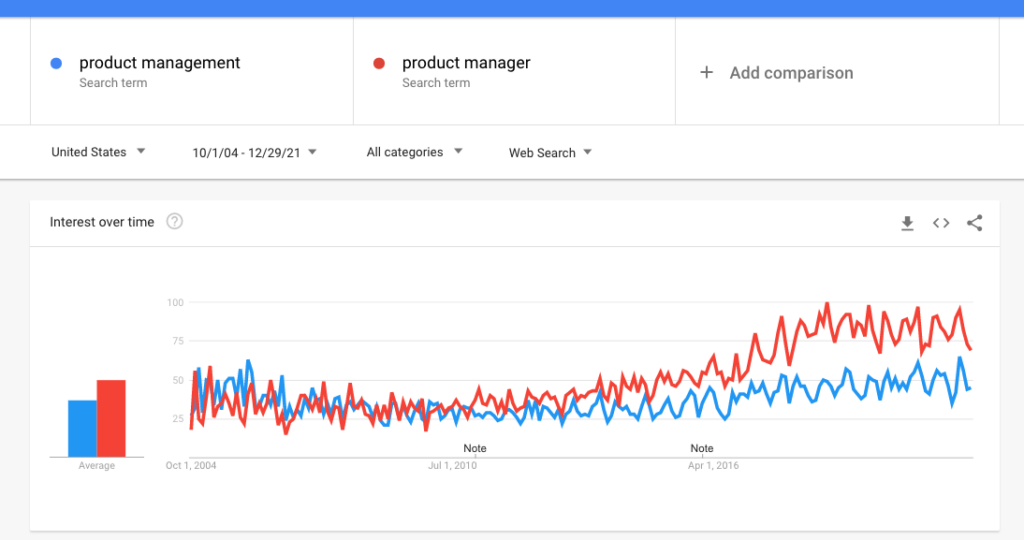Overview
Product management has exploded in popularitity over the last few years. There is big demand to fill the product manager role from start-ups, to medium-size businesses, to large Fortune 500 enterprises.
The average salary when starting out, ~$113,000 USD, is high and the supply of these folks is low.

Simply put, a product manager creates or manages products. In larger companies a PM will partner with a ton of stakeholders in order to craft the strategy, gather requirements, and make sure everyone is on the same boat before the actual product development beings.
Without mincing words, without software engineers, product managers wouldn’t have any products to manage. Product managers will be in charge of the “Why” and the “What” of the work whereas engineers will lead the “How”. As a counter to that, if you’re partnering with tech only on execution and not working with them to brainstorm ideas and get creative, then you’re losing out on one of the best sources of ideas within your team.
Product teams are made up of 3-8 devs (developers, software engineers), an agile scrum master, and a designer. The devs will have a senior dev amongst them who is the tech lead. Not all teams need a scrum master, not all teams need a designer, and by some extension, not all teams need a PM. This type of agile team structure is referred to as an “agile pod” or “pod.
PMs are key in setting the vision, strategy, and roadmap of their products. They will usually be given a north star destination from their leadership. The PM will partner with external stakeholders such as business, user experience, design, marketing, or sales to understand better understand end-user needs.
Differences
The PM role is a job family that can vary a lot between companies and industries. Even within the space of the tech industry, the PM role can vary drastically.
Variables that affect your PM flavor:
- Internal vs external product
- Internal: A product that is solely used by internal users, say for example an internal invoicing tool.
- External: A product that is accessible to the public. A good example is Youtube.
- Technical know-how
- Some products require a high degree of technical ability in order to effectively manage it. A good example are products that make heavy use of machine learning tech. A example of this type of tech is Natural Language Processing (NLP).
- Type of product
- There are lots of types of tech products, some examples are
- Application Programming Interface (API)
- Web appNative desktop app
- Mobile app
- Developer tooling
- Hardware
- Enterprise Resource Plannning (ERP) app
- There are lots of types of tech products, some examples are
- Company size
- This will determine the level of support you’ll get and to what extent you’ll have the freedom to set the product strategy
- New vs existing product
- Even on a team that’s primarily sheperding a product in maintenance mode you’ll create enhancements or new tangentially related products
- Product manager vs product owner
- A product owner is an agile scrum role that is hyper focused on delivery and backlog prioritization
- Unlike the product manager role, the product owner is significantly less involved in the high-level strategy and vision setting
- All product owners are product managers, but not all product managers fulfill the role of a product owner
Summary
The job of the product manager can vary a lot, as you can tell from the above. This makes the job tough, on the other hand, it also means that a lot of people have at least some of the skills necessary to try this out. If you have a background in project management, agile, engineering, marketing, sales, business analysis, data analysis, entrepreneurship, then you already have some of the essential attributes of a PM.
Being a PM is essentially the equivalent of being a “mini-CEO”. One big difference is that, unlike a CEO, you have to lead without authority. Beyond sounding very corporat-y, this means that none of the folks that you’re leading actually report to you. As a result, this means that building buy-in from the partners with whom you work is key.
People who succeed at this are comfortable with ambiguity, competing priorities, interacting with a very diverse set of people, ownership, and setting the direction of work for a team that can be worth multiple millions of $ per year.
